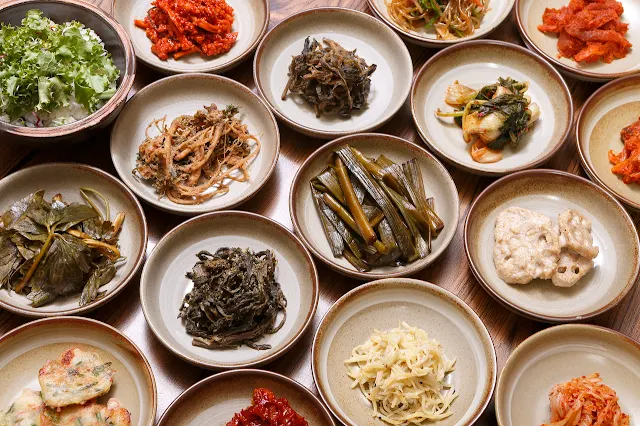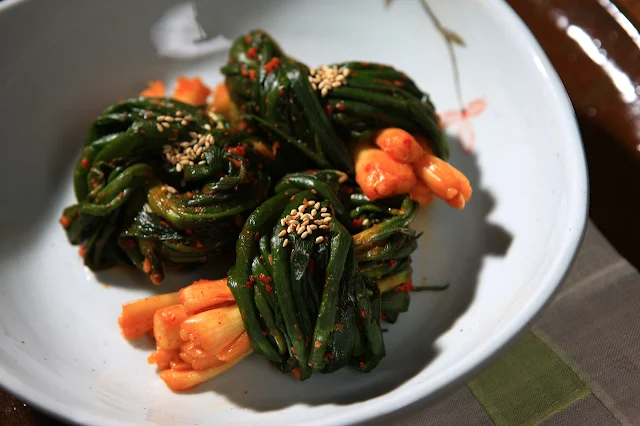Banchan: The Essential Element of Korean Cuisine
When people worldwide think of “Korean
food,” dishes like bulgogi, bibimbap, and kimchi often come
to mind. However, the true charm of Korean cuisine lies in its diverse
array of banchan (반찬, side dishes). A Korean
meal is not just about one or two main dishes—it’s about the harmony of various
small side dishes that come together to create a complete dining experience.
One of the defining features of banchan is
its balance of flavors. Korean food is not just salty or spicy; it blends
sweetness, umami, tanginess, and nuttiness, creating a unique harmony in every
bite. Moreover, banchan is not only delicious but also healthy, thanks to the
use of fresh ingredients and fermented foods packed with probiotics.
Unlike Western meals, where a single main
dish might be the focus, Koreans enjoy a variety of dishes at every meal—rice,
soup, stew, and multiple side dishes all working in harmony. This diversity
brings out the full spectrum of flavors, making each meal a delightful
experience.
 |
| A Variety of Korean Side Dishes [Photo Credit] KTO, Frame Studio |
Banchan and Korean Dining Culture
Koreans don’t just eat one dish at a time.
Instead, they take a bite of rice with fermented sauces or seafood, sip some
soup, and pair grilled meat with tangy vegetables in a lettuce wrap. Much like
an orchestra blending different instruments into a harmonious melody, Korean
dining is the art of combining flavors to achieve the perfect balance.
Thus, banchan is not merely a “side dish” but an essential component of Korean cuisine. Each dish offers a
different combination of sweetness, saltiness, sourness, spiciness, nuttiness,
and umami, providing endless possibilities for new taste experiences. Banchan
completes a meal by adding diversity and complexity to the flavors on the table.
 |
| Five-Grain Rice [Photo Credit] KTO Torai Republic |
Eating just one type of banchan may feel
incomplete, but when paired with rice, soup, and other dishes, it creates an
entirely new dimension of taste. Koreans have perfected the art of food
pairing over generations, naturally understanding which flavors complement each
other best. This is why banchan is not just a side dish but a fundamental
part of a Korean meal’s identity.
Signature Korean Banchan
Korean banchan is often intensely flavored
on its own, making it perfectly balanced when eaten with rice. Many
traditional side dishes have been developed over centuries, centered around
fermentation, seasoned vegetables, and preserved foods. Today, let’s explore
some of the most common and beloved Korean banchan that make everyday
meals more enjoyable.
1. Kimchi – The Symbol of Korean Cuisine
Kimchi (김치)
is Korea’s most iconic fermented dish, boasting many varieties.
While it can be made from various ingredients, the most common versions use
napa cabbage or radish seasoned with chili, garlic, ginger, and fermented
seafood.
Different regions have developed unique
styles of kimchi, leading to over 200 different types, including baechu
kimchi (배추김치, cabbage kimchi), kkakdugi (깍두기, diced radish kimchi), oi sobaegi (오이소박이, spicy stuffed cucumber kimchi), pa kimchi (파김치, green onion kimchi), and gat kimchi (갓김치, mustard leaf kimchi).
 |
| Green Onion Kimchi [Photo Credit] KTO Kim Ji-ho |
Not only does kimchi add a burst of bold
flavor to any meal, but it is also packed with vitamins, minerals,
probiotics, and fiber, aiding digestion, promoting gut health, and boosting
immunity.
2. Namul & Muchim – The Simplicity of Korean Cuisine
Namul (나물) refers
to seasoned vegetable side dishes, representing Korean food's humble and comforting side. These vegetables are either blanched or raw,
then dressed with simple seasonings like sesame oil, soy sauce, salt, garlic,
and sesame seeds.
The ingredients vary by season: in spring,
people enjoy wild greens like chamnamul (참나물), dallae (달래) (Korean wild chives),
and dureup (두릅, aralia shoots), while summer
features refreshing cucumber and perilla leaf salads.
Namul dishes are light yet packed with
nutrients, making them a staple of the Korean diet. They are easy to digest and
provide a great contrast to richer, heavier dishes.
 |
| Spinach Namul [Photo Credit] Wikimedia Commons |
Namul is prepared by mixing the ingredients
with seasonings, which is why it is also called muchim (무침, seasoned dish). For example, once chamnamul (wild chervil) is
prepared, it is called chamnamul muchim (참나물 무침), and once dallae (wild chive) is prepared, it becomes dallae
muchim (달래 무침).
3. Jangajji – Fermented Pickles with Depth
Jangajji (장아찌) refers to pickled vegetables or seafood preserved in soy
sauce, soybean paste, or chili paste. This traditional method allows people to store
seasonal ingredients for long-term enjoyment, enhancing their flavors through
fermentation.
Some of the most popular types of jangajji
include perilla leaf jangajji (깻잎 장아찌),
cucumber jangajji (오이 장아찌), radish jangajji (무
장아찌), and garlic jangajji (마늘 장아찌). These salty, umami-rich pickles add an intense flavor
boost to meals, making them an ideal accompaniment to plain rice.
 |
| Kkaennip Jangajji [Photo Credit] KTO Alex Bundo |
Jangajji embodies the essence of Korean
fermentation—deep flavors developed over time, offering a burst of complex
tastes with every bite.
4. Jeotgal – The Taste of the Sea in Fermented Form
Jeotgal (젓갈)
is a fermented seafood dish that holds a significant place in Korean
cuisine. Made by salting and fermenting various types of fish and shellfish,
this banchan is packed with deep, umami-rich flavors. Popular varieties include myeolchi-jeot
(멸치젓, salted anchovies), saeujeot (새우젓, salted shrimp), myeongran-jeot (명란젓,
salted pollock roe), changran-jeot (창란젓, salted
cod intestines), and ojingeo-jeot (오징어젓, salted
squid).
 |
| Salted Shrimp [Photo Credit] KTO Alex Bundo |
Jeotgal is often used as a seasoning in
kimchi and stews, but it can also be enjoyed as a side dish on its own. Due to
its intense salty and savory taste, a small amount is enough to enhance an
entire bowl of rice. It pairs particularly well with kimchi, further deepening
its fermented flavors. Additionally, jeotgal contributes to the umami
complexity of Korean cuisine thanks to the amino acids that develop during
the fermentation process, making it an indispensable part of Korean dining.
5. Jorim – A Flavorful Braised Side Dish
Jorim (조림)
refers to dishes that are braised in soy sauce and sugar, resulting in a
soft texture and rich, savory taste. Common ingredients include meat, fish,
tofu, and vegetables, simmered slowly to absorb the deep flavors of the sauce.
Popular jorim dishes include dubu-jorim
(두부조림, braised tofu), saengseon-jorim (생선조림, braised fish), beoseot-jorim (버섯조림,
braised mushrooms), and jang-jorim (장조림, soy-braised
beef or pork). Among them, jang-jorim is a beloved dish made by
braising beef or pork in soy sauce, creating a salty and slightly sweet flavor
with a chewy texture.
 |
| Spicy Braised Tofu [Photo Credit] KTO Kim Ji-ho |
Meanwhile, saengseon-jorim, made with
fish like mackerel or hairtail, is cooked in a savory-spicy sauce with soy
sauce, gochujang (고추장, Korean chili paste), and
garlic, offering a perfect balance of heat and umami. These jorim dishes are so
delicious with rice that they are often referred to as “bap doduk” (밥도둑, rice thieves)—meaning they make you eat more rice than you
intended!
6. Jeon – A Special Treat for Celebrations
Jeon (전) is
a pan-fried delicacy often enjoyed on special occasions, such as holidays
and family gatherings. Made by coating meat, vegetables, or seafood in flour
and egg before pan-frying, jeon has a crispy yet soft texture with a
nutty aroma from the oil.
There are many varieties of jeon, including kimchi
jeon (김치전, kimchi pancake), haemul pajeon (해물파전, seafood and green onion pancake), buchujeon (부추전, garlic chive pancake), dongtaejeon (동태전, pollock pancake), nokdujeon (녹두전, mung
bean pancake), and gamjajeon (감자전, potato
pancake).
 |
| Assorted Korean Pancakes and Makgeolli [Photo Credit] KTO Torai Republic |
Among them, kimchi jeon is particularly popular, made with aged kimchi, which brings a tangy, slightly spicy flavor that pairs wonderfully with Korean traditional rice wine (막걸리, makgeolli). Though jeon takes effort to prepare, it is widely loved as a special dish that brings people together during festive occasions.
7. Bokkeum – Stir-Fried Dishes with Bold Flavors
Bokkeum (볶음)
refers to dishes that are stir-fried over high heat with oil and
seasonings, creating an intense umami taste with a slight smoky “fire” flavor.
A wide variety of ingredients can be stir-fried, ranging from vegetables and
seafood to meats.
Some of the most beloved bokkeum dishes
include eomuk bokkeum (어묵볶음, stir-fried
fish cakes), jinmichae bokkeum (진미채볶음, spicy
stir-fried dried squid), gamja bokkeum (감자볶음, stir-fried
potatoes), kimchi bokkeum (김치볶음, stir-fried
kimchi), beoseot bokkeum (버섯볶음, stir-fried
mushrooms), and myeolchi bokkeum (멸치볶음, stir-fried
anchovies).
 |
| Stir-Fried Dried Squid |
Among them, eomuk bokkeum is a
Korean household staple, featuring fish cakes stir-fried in a sweet-savory
soy sauce glaze, making it a favorite among all ages. Jinmichae bokkeum,
on the other hand, is a spicy-sweet stir-fried dried squid dish that
enhances any meal with its bold flavors.
Since bokkeum dishes are rich, salty,
and packed with umami, they are perfectly suited to be eaten with rice,
making them a must-have on the Korean dining table. Additionally, bokkeum is a great
way to use leftover ingredients, making it a practical yet delicious part of
everyday Korean meals.
8. Jjim – Steamed Delicacies with a Soft Texture
Jjim (찜)
refers to steamed or braised dishes until tender, often resulting
in a moist, melt-in-your-mouth texture with deep, infused flavors. While some
jjim dishes like galbijjim (갈비찜, braised
short ribs), jjimdak (찜닭, braised chicken),
agwijjim (아귀찜, braised monkfish), and haemuljjim
(해물찜, braised seafood) are served as main
courses, there are also lighter jjim dishes that work as side dishes.
Popular steamed banchan includes gyeran
jjim (계란찜, steamed egg), gaji jjim (가지찜, steamed eggplant), dubu jjim (두부찜, steamed
tofu), and eomuk kongnamul jjim (어묵콩나물찜, steamed
fish cake and bean sprouts).
 |
| Steamed Egg Custard |
Gyeran jjim is a universally loved
dish known for its soft, custard-like texture, making it easy to enjoy at any
meal. Gaji jjim, or steamed eggplant, absorbs soy-based seasonings
beautifully, creating a savory, silky bite. Since jjim dishes use
minimal oil, they are considered healthy and light, making them a popular
choice for those looking for clean, nutritious side dishes.
9. Twigim – Crispy, Deep-Fried Goodness
Twigim (튀김)
refers to deep-fried dishes that enhance ingredients' natural flavors with a crispy outer layer. Unlike jeon, which uses a light flour
and egg coating, twigim dishes often involve a thicker batter or directly deep-frying ingredients.
Popular types of twigim include goguma
twigim (고구마 튀김, sweet potato tempura), ojingeo
twigim (오징어 튀김, fried squid), gim-mari twigim (김말이
튀김, deep-fried seaweed rolls), and gaji twigim (가지
튀김, fried eggplant).
 |
| A plate of fried food [Photo Credit] KTO, Torai Republic |
Among them, goguma twigim is a
favorite for its naturally sweet flavor and crispy texture, while ojingeo
twigim delivers a delightful contrast between a chewy interior and
crunchy exterior. Gim-mari twigim, which consists of seaweed rolls
filled with glass noodles, is often served with tteokbokki for an extra
indulgent treat.
Twigim is a go-to comfort food and a
festive treat, adding variety and texture to a Korean meal. Whether enjoyed as banchan
or as a standalone snack, it brings an irresistible crunch to the table.
The Modern Evolution of Korean Banchan
As food trends shift, modern Korean
banchan has evolved beyond traditional recipes. Many new versions focus on lower
sodium and reduced sugar, aligning with contemporary health-conscious dining
habits. Additionally, the rise of plant-based diets has led to the
creation of vegan-friendly banchan that retain the essence of
traditional Korean flavors.
To appeal to a global audience, fusion-style
banchan has also gained popularity, adapting traditional Korean flavors
into internationally inspired dishes. These innovations help Korean
banchan thrive in the global culinary scene, making it more accessible and
appreciated worldwide.
Final Thoughts: The True Art of Korean Banchan
Korean banchan are not just a side
dish but a culinary masterpiece encapsulating Korean food culture.
From the spicy kick of kimchi to the delicate umami of fermented jeotgal, the
nutty aroma of namul, and the crispy texture of twigim, each banchan contribute
to a well-balanced meal.
Many foreign YouTubers have recently showcased their reactions to Korean banchan, often marveling at their intense
flavors. However, to truly appreciate the essence of banchan, it must be
eaten with rice—that is when its true magic unfolds.
For those who wish to experience Korean
cuisine in its most authentic form, embracing the art of banchan is the
key. So, next time you sit down to a Korean meal, take your time to explore the
flavors—and you just might find yourself becoming an expert in the art of
Korean dining!
0 Comments